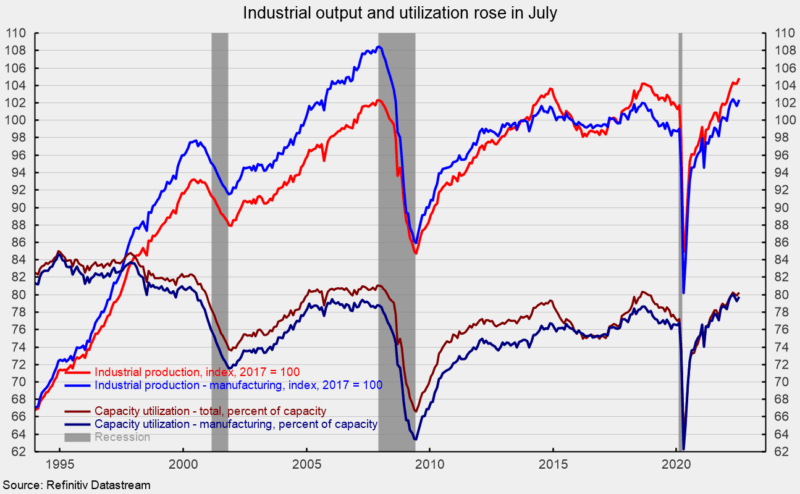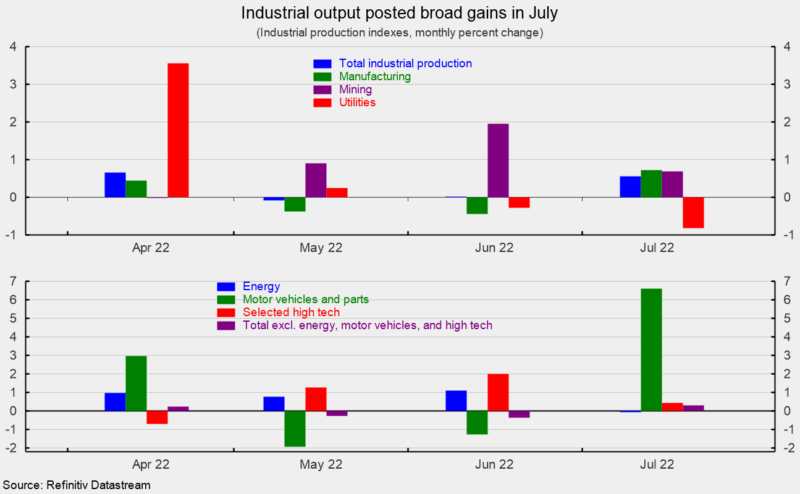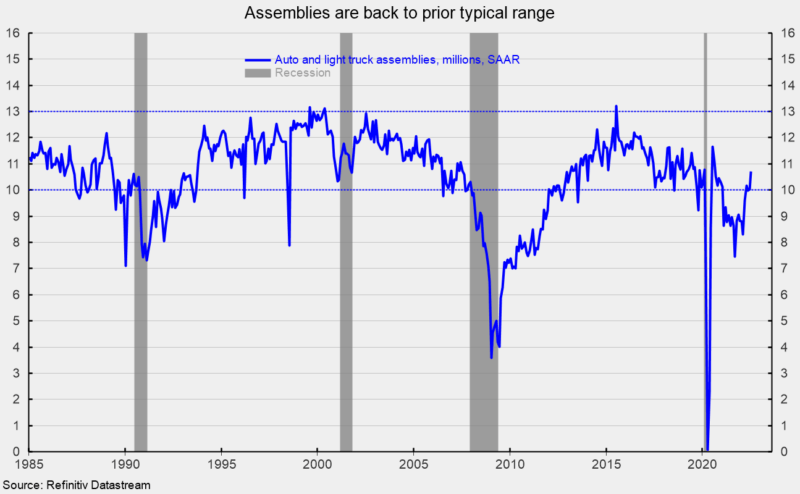Industrial Output Posts Solid Gains in July
Total industrial production increased 0.6 percent in July after being unchanged in June. Over the past year, total industrial output is up 3.9 percent and is at an all-time high (see first chart).
Total industrial capacity utilization increased 0.4 points to 80.3 percent from 79.9 percent in June, matching the post-lockdown recession high. The July utilization is above the long-term (1972 through 2021) average of 79.6 percent but well below the highs of the 1970s when it was above 88 percent.
Manufacturing output – about 74 percent of total output – posted a solid 0.7 percent gain for the month (see first chart). From a year ago, manufacturing output is up 3.2 percent.
Manufacturing utilization increased 0.5 point to 79.8 percent, holding above its long-term average of 78.2 percent. However, it remains well below the 1994-95 high of 84.7 percent.
Mining output accounts for about 16 percent of total industrial output and posted a solid 0.7 percent increase last month following a 2.0 percent gain in June and 0.9 percent rise in May (see top of second chart). Over the last 12 months, mining output is up 7.9 percent.
Utility output, which is typically related to weather patterns and is about 10 percent of total industrial output, fell 0.8 percent with natural gas off 1.0 percent and electric down 0.8 percent. From a year ago, utility output is up 2.2 percent.
Among the key segments of industrial output, energy production (about 27 percent of total output) fell 0.1 percent for the month (see bottom of second chart) with gains in oil and gas well drilling and primary energy production but declines in consumer energy products and converted energy products; commercial energy products were unchanged for the month. Total energy production is up 5.3 percent from a year ago.
Motor-vehicle and parts production (slightly under 5 percent of total output), one of the hardest-hit industries during the lockdowns and post-lockdown recovery, surged 6.6 percent in July (see bottom of second chart). From a year ago, vehicle and parts production is up 13.3 percent.
Total vehicle assemblies rose to 11.04 million at a seasonally-adjusted annual rate. That consists of 10.72 million light vehicles (see third chart) and 0.32 million heavy trucks. Within light vehicles, light trucks were 8.80 million while cars were 1.92 million. Assemblies have risen sharply from the lows and have finally returned to prior typical range.
The selected high-tech industries index gained 0.4 percent in July (see bottom of second chart) and is up 8.9 percent versus a year ago. High-tech industries account for just 2.1 percent of total industrial output.
All other industries combined (total excluding energy, high-tech, and motor vehicles; about 66 percent of total industrial output) rose 0.4 percent in July (see bottom of second chart). This important category is 2.4 percent above July 2021. Overall, industrial output posted broad-based gains in July, hitting a new record high. Manufacturing output gained despite ongoing labor shortages and turnover, rising costs and shortages of materials, and logistics and transportation bottlenecks. However, there continues to be progress on some of these issues. Elevated price increases, weak consumer sentiment, an intensifying Fed tightening cycle, fallout from the Russian invasion of Ukraine, and Covid-19-related problems in China remain significant threats to the economic outlook. Caution is warranted.








